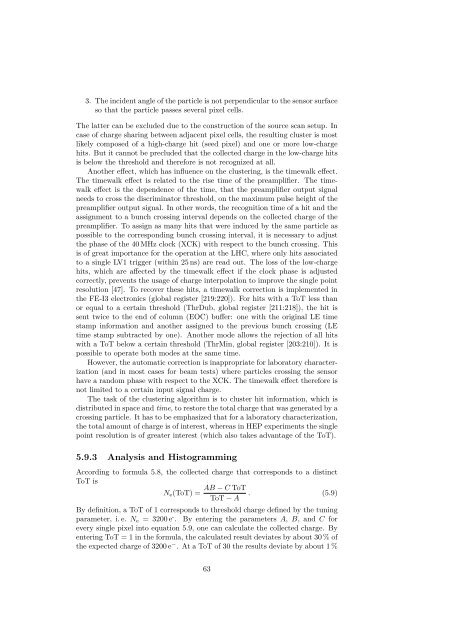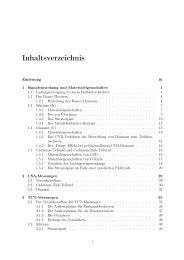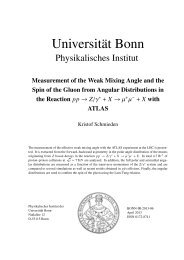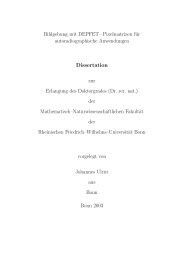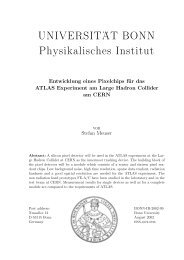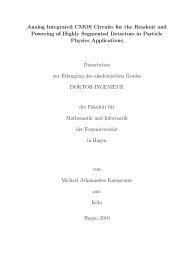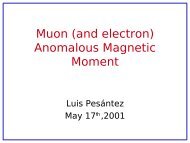Jens Janssen Diploma Thesis - Prof. Dr. Norbert Wermes ...
Jens Janssen Diploma Thesis - Prof. Dr. Norbert Wermes ...
Jens Janssen Diploma Thesis - Prof. Dr. Norbert Wermes ...
You also want an ePaper? Increase the reach of your titles
YUMPU automatically turns print PDFs into web optimized ePapers that Google loves.
3. The incident angle of the particle is not perpendicular to the sensor surfaceso that the particle passes several pixel cells.The latter can be excluded due to the construction of the source scan setup. Incase of charge sharing between adjacent pixel cells, the resulting cluster is mostlikely composed of a high-charge hit (seed pixel) and one or more low-chargehits. But it cannot be precluded that the collected charge in the low-charge hitsis below the threshold and therefore is not recognized at all.Another e ect, which has influence on the clustering, is the timewalk e ect.The timewalk e ect is related to the rise time of the preamplifier. The timewalke ect is the dependence of the time, that the preamplifier output signalneeds to cross the discriminator threshold, on the maximum pulse height of thepreamplifier output signal. In other words, the recognition time of a hit and theassignment to a bunch crossing interval depends on the collected charge of thepreamplifier. To assign as many hits that were induced by the same particle aspossible to the corresponding bunch crossing interval, it is necessary to adjustthe phase of the 40 MHz clock (XCK) with respect to the bunch crossing. Thisis of great importance for the operation at the LHC, where only hits associatedto a single LV1 trigger (within 25 ns) are read out. The loss of the low-chargehits, which are a ected by the timewalk e ect if the clock phase is adjustedcorrectly, prevents the usage of charge interpolation to improve the single pointresolution [47]. To recover these hits, a timewalk correction is implemented inthe FE-I3 electronics (global register [219:220]). For hits with a ToT less thanor equal to a certain threshold (ThrDub, global register [211:218]), the hit issent twice to the end of column (EOC) bu er: one with the original LE timestamp information and another assigned to the previous bunch crossing (LEtime stamp subtracted by one). Another mode allows the rejection of all hitswith a ToT below a certain threshold (ThrMin, global register [203:210]). It ispossible to operate both modes at the same time.However, the automatic correction is inappropriate for laboratory characterization(and in most cases for beam tests) where particles crossing the sensorhave a random phase with respect to the XCK. The timewalk e ect therefore isnot limited to a certain input signal charge.The task of the clustering algorithm is to cluster hit information, which isdistributed in space and time, to restore the total charge that was generated by acrossing particle. It has to be emphasized that for a laboratory characterization,the total amount of charge is of interest, whereas in HEP experiments the singlepoint resolution is of greater interest (which also takes advantage of the ToT).5.9.3 Analysis and HistogrammingAccording to formula 5.8, the collected charge that corresponds to a distinctToT isAB ≠ C ToTN e (ToT) =ToT ≠ A . (5.9)By definition, a ToT of 1 corresponds to threshold charge defined by the tuningparameter, i. e. N e = 3200 e - . By entering the parameters A, B, and C forevery single pixel into equation 5.9, one can calculate the collected charge. Byentering ToT = 1 in the formula, the calculated result deviates by about 30 % ofthe expected charge of 3200 e ≠ . At a ToT of 30 the results deviate by about 1 %63


